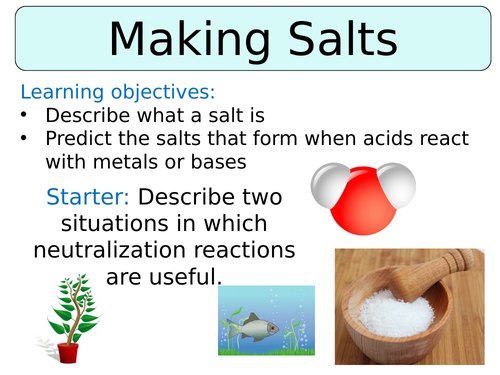
This lesson is designed for the Activate KS3 Science Course, specifically Year 7 C4 ’Acids & Alkalis’.
For more lessons designed for KS3 and KS4 please visit my shop at: https://www.tes.com/teaching-resources/shop/SWiftScience.
This lesson begins with an introduction to the chemical formulae of the three main acids, students are asked to consider what they have in common - hopefully they should all identify that the chemical formulae of each acid contains hydrogen atoms.
Students are now given some information about salts, which are made as a result of an acid and a base reacting together. Students will need to read the information and answer a set of questions, this work can then be self-assessed using the mark scheme provided.
Students will be introduced to the different types of reactions which make salts, e.g. metals reacting with acids and acids reacting with bases. Students will then watch a video observing a metal reacting with an acid, they will need to note down the observations they make during the reaction.
Students will then be shown some examples of word equations for metals reacting with acids and a pattern will be pointed out to students, to help them write word equations for other metals with acid combinations. Students will then need to finish off the word equations for a set of metal and acid reactants, this task can be self-assessed using the mark scheme once it is complete.
Next, students are introduced to the basic word equation for a base and an acid -> salt plus water. Students can then practice finishing the word equations for a set of base and acid reactants, this task can also be marked and corrected using the answers provided on the PowerPoint. Students can now summarise what they have learned so far by completing a ‘fill-in-the-blank’ task, this work can be self-assessed using the mark scheme provided.
Lastly, students will complete a practical investigation to make their own salt crystals. The practical worksheet is provided, students can follow the method in pairs or small groups.
The plenary task requires students to write a list of key words that they have learned over the course of the ‘Acid & Alkali’ topic.
All resources are included at the end of the presentation. Thanks for looking, if you have any questions please let me know in the comments section and any feedback would be appreciated :)
Get this resource as part of a bundle and save up to 30%
A bundle is a package of resources grouped together to teach a particular topic, or a series of lessons, in one place.
Something went wrong, please try again later.
This resource hasn't been reviewed yet
To ensure quality for our reviews, only customers who have purchased this resource can review it
Report this resourceto let us know if it violates our terms and conditions.
Our customer service team will review your report and will be in touch.
